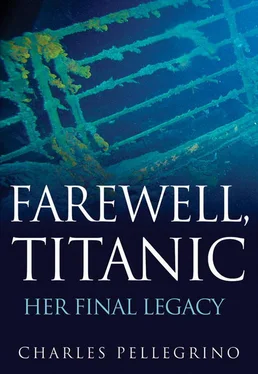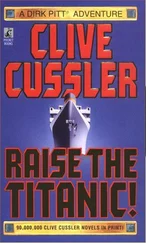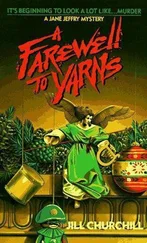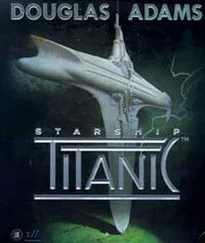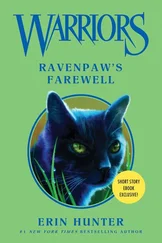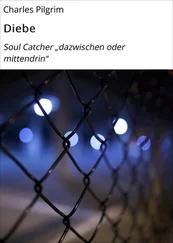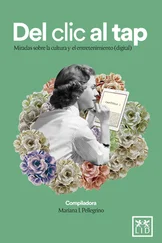J. Chatterton, Carl Spencer, and the Shadow Divers unit at the Britannic : B. Matsen, The Titanic’s Last Secrets (New York: Twelve, 2008), 245, 252–255. Chatterton’s and a colleague’s encounter with illness as an apparent result of rusticle infection at the Britannic : Roy Cullimore, Lori Johnston, and Mark Newman, personal communication, 2005–2012; Matsen, 259.
In 2008, Carl Spencer, the polymath explorer, was working with the microbiologists: Roy Cullimore, letter to author, Nov. 2010; Roy Cullimore and Lori Johnston, personal communication. Tests had already shown a tremendous acceleration of rusticle reefing on the Britannic : Cullimore and Johnston, “Microbial Evaluation of the Potential at-Site Corrosion of the Steels Used in the Construction of HMSS Britannic ,” Forensic Microbial Service , Droycon Bioconcepts Inc., Saskatchewan, Canada, Jan 12, 2011.
After setting the new GUCCI rack and two new bacterial etching experiments on the Britannic , Spencer’s rebreather system malfunctioned: Cullimore, letter to author, Nov. 11, 2010; Johnston, letters to author, Jan. 2011 and Feb. 14, 2011. The National Geographic support ship was equipped with a portable hyperbaric chamber, but Spencer never revived: Carl Spencer death inquest outcome, Feb. 14, 2011.
Notes on how the aftermath of a trauma (as in the case described by Ellen Betty Phillips) can eat away at one’s heart as badly as the event itself: Charles Pellegrino, video log, WTC surge cloud effect survey.
Ten-Ten House “apparitions” and “ghosts of the imagination”: John Morabito, personal communications, 2002– 2005. Events, second and third time, “saved” by Paddy Brown: Charles Pellegrino, John Pellegrino, family history.
On Masabumi Hosono and his family during the century after the Titanic : Fumiko Hosono, in M. Findlay, “The Fateful Voyage of Masabumi Hosono,” Voyage 27, Winter 1998, pp. 128–129; Kae Matsumoto and Hideo Nakamura, letters to author, Feb. and Mar. 2011.
Unlike most techno or new wave bands of the 1980s, YMO’s popularity grew slowly and steadily: http://www.youtube.com/watch?v=sJgtyMbfYAY&feature=relted. Their 2011 hit (in homage to Masabumi Hosono’s perseverance) was titled “You’ve Got to Help Yourself.”
Return to the Keldysh in 2003 and Captain Paul Mallery’s lesson to the Keldysh about thinking outside the box: Paul Mallery, e-mail log, Expedition X-Treme Life , July 23, 2003, p. 16, July 28, 2003, pp. 22–23.
“Russian-think,” applied by James Cameron to the evolution of the cephalopods: Charles Pellegrino, correspondence with Arthur C. Clarke, e-mail log, Expedition X-Treme Life , July 31, 2003, p. 40. James Cameron, Keldysh crew, and NASA astrobiology team, personal communications, Expedition X-Treme Life , July 31, 2003.
The search for hydrothermal vent origins of the Titanic ’s rusticle reef: Charles Pellegrino, written log, Expedition X-Treme Life , July 31, 2003, pp. 39, 47–49.
A recurrence of “World Trade Center cough” at sea and the news from our ship’s surgeon, Dr. Glenn Singleman, that I would never see the Titanic again: Pellegrino, written log, Expedition X-Treme Life , Aug. 3, 2003, pp. 20, 43. Mary Leung, e-mail to author, Expedition X-Treme Life, Aug 6, 2003, p. 62.
The colorful history of “rocket fuel” in a drink called Sheila: Pellegrino, written log, Expedition Titanic XIII , Sept. 23, 2001, p. 272.
“The cup is half full,” I told myself, as I prepared for the last dive of my career: Pellegrino, written log, Expedition X-Treme Life , Aug. 7–8, 2003, pp. 46, 67, 68. Abiotic organic material forms the base of the Lost City food chain: G. Prokurowski et al., “Abiotic Lost City Organics,” Science , Feb. 1, 2008; S. Perkins et al., “Sea Floor Chemistry: Life’s Building Blocks Made Inorganically [Lost City Vents],” Science News , Feb. 2, 2008.
Discovery of Lost City: Science News , July 14, 2000. Investigation of hydrothermal vents, abiotic matter in carbonaceous meteorites (pioneered by H. C. Urey, B. Nagy, and C. E. Folsome), with implications for subsurface seas of certain moons of Jupiter and Saturn (especially Titan and Enceladus): Charles Pellegrino and Jesse Stoff, notes and correspondence, J. Stoff, R. Ballard, 1978; Darwin’s Universe: Origins and Crises in the History of Life , 2nd ed. (New York: Van Nostrand Reinhold, 1983).
The Lost City dive was documented in Pellegrino, dive log and video log, Expedition X-Treme Life , Aug. 8. 2003, pp. 79–130.
Ground zero lung, preparations (as land crew) for the 2005 Titanic expedition: Charles Pellegrino, Paul Mallery, et al., written log, Expedition X-Treme Life , Aug. 6–14, 2003, pp. 57, 58, 60, 61, 62B, 75, 77, 92, 102, 103, 104, 107, 108.
Revelations about the Titanic ’s misnamed, misunderstood (and fortunately not mistreated) white worm: James Cameron, Last Mysteries of the Titanic, Discovery Channel, 2005. Other 2005 expedition notes relevant to shock cocoons, breakup of the Titanic , and sea floor impact: James Cameron, letters to C. Pellegrino and R. Long, in “Archaeology of the Titanic ,” Explorers , Part 3, http://www.charlespellegrino.com, pp. 5, 7, 11, 12, 17–18, 37.
The discovery of more shock-cocooned chambers inside the Titanic and a new rusticle morphology: James Cameron and Charles Pellegrino, in “Archaeology of the Titanic ,” Explorers , Part 2, http://www.charlespellegrino.com, pp. 1–4; Lynn Margulis interview, Discover , Apr. 2011, pp. 66–71.
The same “electron racetrack” found in hemoglobin is found throughout nature, the chief difference being the metal at the center of the “racetrack”: magnesium for plants, copper for insects, and iron for birds and mammals. On the Titanic , we have seen that the rusticle makes use of whatever metals are available: iron, copper, and zinc. The mystery of “rusticle flowers” in Maude Slocomb’s Turkish baths was discussed by James Cameron, Charles Pellegrino, Roy Cullimore, Lori Johnston, and Anthony El-Khouri in correspondence beginning in Apr. 2011.
El-Khouri’s study of the rusticle flower video revealed three relevant trends: El-Khouri, letter to author, Apr. 25, 2011; Cullimore, letter to author, Apr. 26, 2011. Cullimore’s observations pointed Occam’s razor toward a “rust flower” kinship with the anoxic microbial reeds growing on (and protecting) the Titanic ’s mail bags, and his photos show rusticles growing up , in the laboratory. The nutrient base was ferro-rich narrow-spectrum fatty acids. Cullimore relied on iron-reducing bacteria (from rusticles) to start the oxidative-reductive cycle and switched to ferrous as required.
Cullimore’s observations about bacterially produced iron deposits having been made into Titanic ’s steel, being returned now to the earth as iron ore again, by microbiology: Pellegrino and Cullimore, video log, Expedition Titanic VIII , 1996.
Humans repeat history again. In Masabumi Hosono’s generation, large stone tablets were erected warning of the heights reached by tsunamis: J. Alabaster, “Tsunami-Hit Towns Forgot Warnings from Ancestors,” Associated Press, Apr. 6, 2011; A. Revkin, “Limits of Disaster Memory, Even Etched in Stone,” New York Times , Apr. 8, 2011.
Guglielmo Marconi, whose apparatus was largely responsible for saving those who escaped the Titanic in lifeboats, noted how often the lessons of the past tended to be ignored, and he was much distressed by the sinking of the Titanic and by subsequent avoidable repetitions: Gioia Marconi Braga (his daughter), letter to author (with family memoir and letters), Aug. 10, 1995; Degna Marconi, My Father Marconi (New York: McGraw-Hill, 1962), 198.
Читать дальше
